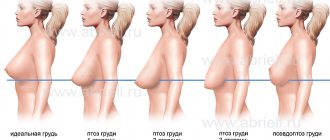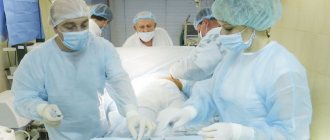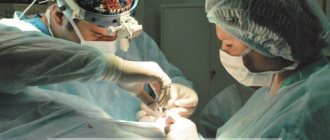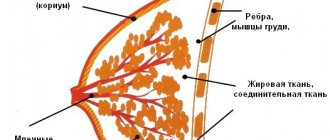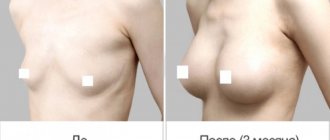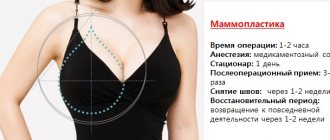Indications and contraindications
Augmentation mammoplasty is an invasive procedure. During the operation, many blood vessels and other tissues are affected, so only a completely healthy body can endure the rehabilitation period well.
If you want to enlarge your breasts, you need to familiarize yourself with the full list of indications and contraindications for mammoplasty.
When to resort to such intervention:
- psychological discomfort of a woman due to small breasts;
- visually noticeable asymmetry;
- loss of attractive shape after pregnancy and breastfeeding;
- restoration of a lost breast due to surgery;
- mammary glands are disproportionate to the body.
Often, middle-aged women also resort to augmentation mammoplasty. Over the years, the breasts lose their attractiveness and elastic shape, which can be easily corrected with the help of this operation.
Invasive intervention in the body is prohibited in the following conditions:
- pregnancy, breastfeeding;
- hormonal disbalance;
- presence of infection in the body;
- reduced immunity;
- oncology;
- diseases with blood clotting disorders;
- diabetes;
- HIV, hepatitis and other serious diseases;
- intolerance to anesthesia;
- mental and neurological diseases;
- problems with the cardiovascular system;
- renal, liver failure;
- age up to 18 years.
Technique for endoscopic breast augmentation surgery and the advantages of the technique. Come here if you are interested in the question: is it possible to enlarge your breasts with iodine?
At this address https://cosmetolog-expert.ru/plastika-tela/grudi/uvelichenie-g/pochemu-ne-rastet.html we will discuss why breasts may not grow during pregnancy.
Breast lift – mastopexy
Mastopexy is used for breast ptosis, when the skin loses its elasticity and the breasts begin to sag. There are 3 degrees of ptosis that are used in diagnosis. Based on the position of the nipple in relation to the submammary (inframammary) fold, the degree of the problem is determined, and appropriate techniques are selected.
Mastopexy is one of the few plastic surgeries that can be performed using local anesthesia and does not require general anesthesia.
To perform mastopexy, the techniques described below are used:
- Periareolar mastopexy is a surgical tightening of the breast skin using an incision around the areola of the nipple. The advantage of the technique is that the breast tissue is not affected - only the skin is corrected. The technique under consideration is used in the treatment of first-degree ptosis for minor correction.
- T-shaped mastopexy is a method of breast lift by partial excision of skin areas. An incision is made along the edges of the nipple areola, moving vertically to the inframammary fold. The technique is relevant for the treatment of mastoptosis of 2 and 3 degrees. Sometimes combined with reduction mammoplasty to avoid postoperative complications due to excessive breast volume.
- Vertical mastopexy - incisions are made along the contour of the nipple areola and vertically, up and down. During the operation, an unnecessary area of skin is removed and the gland tissue is sutured.
In some cases, with a slight degree of mastoptosis, the augmentation method is used. The problem of sagging breasts is solved by implanting a small anatomically shaped implant.
Preparation rules
Before mammoplasty, it is necessary to undergo a thorough examination. This will help prevent almost all postoperative risks, learn about the condition of the body and identify hidden diseases.
What research is needed:
- blood test (biochemical, group and rhesus, for sugar, for coagulation and infectious lesions);
- general urine analysis;
- fluorography;
- electrocardiogram;
- consultation with a mammologist and mammography.
If you have any chronic diseases, it is recommended to take a conclusion about the duration of remission. With all the tests completed, it is necessary to visit the general practitioner’s office so that he can confirm the safety of the future operation.
One and a half weeks before breast augmentation you should limit:
- alcohol consumption;
- smoking;
- stress, nervous tension;
- use of blood thinning medications.
The operation is not recommended during menstruation, or if the body temperature is elevated for no apparent reason.
Access methods
You are 18 years old? If yes, click here to view photos.
[collapse]
To place the implant, the specialist makes an incision in a specific area. There are 3 ways to further access and shape the pocket. The position of the future suture is chosen by the surgeon, taking into account the characteristics of the body.
Types of cuts:
- Submammary. Surgical access is made through an incision under the breast, where a natural fold is formed. Subsequently, the implant is placed under the muscle, and the mammary gland itself is located on top of it.
- Axillary (Axillary). It assumes the location of the suture in the armpit area. The operation is considered quite complex, so only an experienced surgeon can perform it efficiently.
- Periareolar. This method of incision implies its location along the lower border of the areola. After some time after healing, the seam becomes almost completely invisible.
Is it possible and how to grow breasts at home? In this article we will tell you how to regain the shape of your breasts after childbirth.
Here https://cosmetolog-expert.ru/plastika-tela/grudi/rekonstruktsiya/isklyuchenie-tubulyarnoy-deformatsii.html read about methods of tubular breast enlargement.
Laser endoscopic
Laser correction of breast shape and size is an alternative to traditional surgery. The operation is performed using a hardware method using a laser endoscope. The peculiarity and advantage of the technique is the minimal size of scars and rapid recovery.
During the operation, incisions are made in the armpit or inframammary fold for implantation.
List of advantages of laser endoscopic mammoplasty:
- allows to minimize blood loss;
- low risk of further complications;
- short rehabilitation period
- Due to the ability to visualize the process, the risk of medical error is reduced.
Types and location of implants
There are different types of implants, which offer some differences in feel. They differ not only in filler, but also in surface texture.
Today, plastic surgeons prefer the rough shell, as it is better fixed with natural tissues.
According to filling, implants are:
- silicone;
- saline;
- hydrogel.
Regardless of the composition, a cohesive (viscous) gel is always used. This prevents the risk of it leaking into the breast tissue if the implant ruptures.
The endoprosthesis can be placed in different layers of tissue. Their fixation and the shape of the new mammary gland depend on this.
Types of location:
- Subfascial - the implant is located under the muscle. This helps not only secure it firmly into the chest, but also makes it completely invisible.
- Subglandular - the endoprosthesis is installed immediately behind the ducts of the mammary gland. With this method, an unnaturally shaped implant will be noticeable.
The result after plastic surgery also depends on the shape of the prosthesis. Manufacturers offer round and teardrop shapes, of which the second option is more natural.
Algorithm of actions
The patient arrives at the clinic the day before or immediately on the day of surgery. The night before breast surgery, your specialist may offer a sedative to help you sleep well and relieve stress before the procedure.
In the morning, the nurse assesses the condition of the body - measures temperature and blood pressure.
Within a few hours, the anesthesiologist conducts a conversation with the client and finds out the presence of any diseases, which helps him choose the appropriate anesthesia option. At the appointed hour, the patient is sent to the operating room:
- Premedication and anesthesia are performed. It involves the introduction of relaxing medications that help prepare the body for serious sleeping pills.
At this stage, all preparatory procedures are carried out - catheters are installed, the body is connected to equipment to monitor the condition. Full anesthesia is administered. - The operation itself. The plastic surgeon makes an incision in the previously selected area.
Then, using special tools, the tissue is carefully removed to form a pocket for further installation of the implant. The bleeding is stopped by cauterization. Then the specialist takes the future endoprosthesis out of the individual sterile packaging and places it into the chest through the incision, installing it in the right place.
When the surgeon is completely satisfied with the quality of his work, cosmetic sutures and a fixing bandage are applied. Then shapewear is put on the chest, which will help the implant stay in the right place.
After operation
After the operation, the patient usually spends a day in the hospital under the supervision of medical personnel, then she can leave the clinic. Dressings are carried out once every three days for the first two weeks. Sutures are removed on the 10th day after mammoplasty. Next, the patient comes to the clinic for routine examinations every month, 6 months, or a year. You must wear a special compression bra for 2–3 weeks.
Planning pregnancy should be postponed for six months after breast augmentation surgery. Active sports can be continued after 1–2 months.
If you dream of ideal breasts, contact the specialists of the Yauza Clinical Hospital. We have all the capabilities to perform plastic surgery for breast correction, the results of which you will be satisfied with.
The operation was performed by G. R. Abovyan make an appointment for a consultation
Rehabilitation
The full rehabilitation period is six months. You will need to wear shapewear for about 4 weeks, and follow other specialist recommendations for a month.
General recommendations
The final result depends not only on the qualifications of the surgeon, but also on the actions of the woman during the rehabilitation period. All doctor’s instructions must be strictly followed, since after the intervention there is a high probability of complications developing.
Recommendations for the rehabilitation period:
- Anesthesia. The first few days a woman will experience severe chest pain, so there is a need to take analgesics. Antibiotics are also required to reduce the risks of infectious problems.
- Swelling. To relieve tissue swelling, you need to avoid thermal procedures, physical activity, and hot baths for 2 weeks. Sexual arousal can increase pain and contribute to the development of complications, so it is necessary to limit contact while wearing compression garments.
- Linen. You will need to wear a support corset for 4-8 weeks; it can only be removed with the doctor’s permission.
- Massage. After implant placement, it is recommended to perform breast massage to prevent capsular contracture. This can only be done after consultation with a surgeon, but not earlier than 2 weeks.
Nutrition
The diet should help the body recover in an accelerated manner. To relieve excess stress from it, you need to give preference to light food.
On the first day after anesthesia, it is better to opt for light broths to start the digestion process. Gradually you can introduce other products.
The diet should consist of plenty of fruits, fortified shakes and foods containing iron. After such a serious intervention, it is recommended to eat something sweet; pomegranate or apple juice will also be of great benefit.
Care
It is necessary to properly care for a postoperative wound. This will prevent not only purulent complications, but will also affect the quality of the healed suture. Most surgeons prefer self-absorbable sutures that do not require removal.
After about a week, you will only need to remove the protruding nodules. Applying a plaster to fix the suture, as well as wearing a special corset, will help prevent the formation of a rough scar.
For the first few days, it is recommended to treat the seam with a solution of brilliant green and hydrogen peroxide. Then you need to switch to an ointment containing dexpanthenol - it promotes rapid cell regeneration and tissue healing.
When the scabs fall off, you can start using Contractubex to prevent the formation of a visible scar.
If breast implants were placed 10-15 years ago, do they need to be replaced?
— Everything is very individual. It cannot be said that implants from one manufacturer last a lifetime and not from another. Doctors cannot predict how the implant will behave years from now. I repeat: the interaction with the implant is influenced by many factors - immune status, hormonal levels, age, and health status change.
I want to encourage our future, current and former patients not to be subject to the hysteria about implants and their removal. When there is a rupture, capsular contracture, or suspicion of some infectious or oncological diseases, then, of course, you need to check both your health and the implants. But this does not mean that you need to run and delete everything at once! After all, this is followed by the next stage - what will happen to the breast next?
Consequences and complications
A good specialist will always warn the patient about all possible risks and complications after surgery.
Consequences after augmentation mammoplasty:
- Wound infection . It develops due to an incorrect approach to asepsis and antisepsis, as well as insufficient wound care. Inflammation is eliminated with antibacterial agents, and if there is pus, repeated intervention will be required.
- Capsular contracture. Explained by the individual characteristics of the body. It can be eliminated with the help of massage, medications, and in the severe stage it can be removed surgically.
Also after the operation there is swelling, pain and the appearance of hematomas. This is a normal reaction of the body to invasive intervention. It can be eliminated by following all the recommendations that the surgeon warned about.
Causes of capsular fibrosis
The development of capsular contracture occurs for a number of reasons, which can be divided into 4 groups:
- Reasons associated with the operation:
- formation of extensive postoperative hematomas;
- accumulation of serous fluid around the implant due to detachment of subcutaneous tissue during surgery;
- wound infection;
- rough operating technique;
- the small size of the formed pocket, due to which the implant stretches the soft tissues;
- the occurrence of inflammatory processes at the site of the incision.
- Reasons associated with endoprostheses:
- the large size of the endoprosthesis compared to the cavity prepared for its placement, which entails deformation of the implant;
- installation of an endoprosthesis under the mammary glands, and not in the intermuscular space;
- rupture of the endoprosthesis and filling of the cavity between the implant and fibrous tissues with silicone particles;
- fogging of the endoprosthesis and, as a result, accumulation of silicone on the surface of its shell.
- Reasons caused by the individual characteristics of the body:
- allergic reaction to the installed endoprosthesis;
- the body's predisposition to the formation of rough scars.
- External reasons:
- the presence of bad habits and their negative impact on the body;
- excessive physical activity that affects the pectoral muscles;
- non-compliance with the recommendations prescribed by the doctor;
- trauma to the chest, leading to the formation of hematomas and seromas.
Price issue
The average cost of augmentation mammoplasty in Russia ranges from 200-350 thousand rubles.
Most clinics offer, which includes a preliminary consultation with doctors, the operation itself, a hospital stay and a compression corset.
The price formation is also influenced by the experience and length of service of the surgeon, and his fame.
You are 18 years old? If yes, click here to watch the video.
[collapse]

